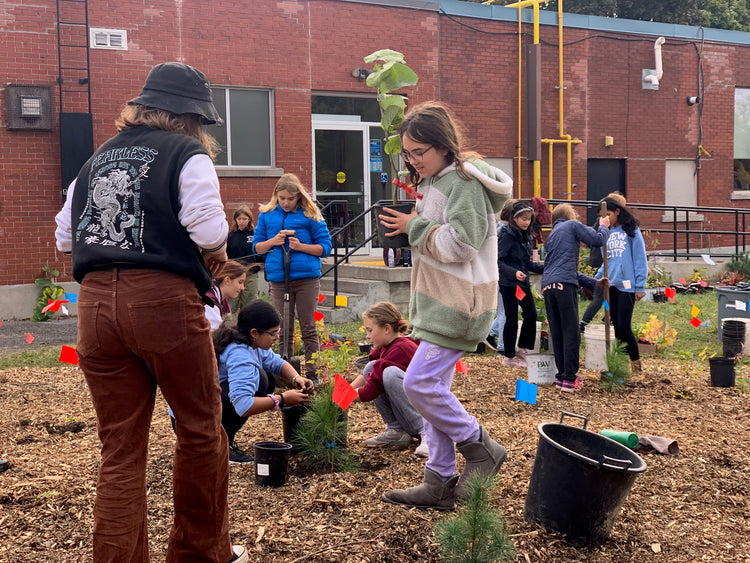The Portsmouth Community Little Forest is located on urban land that was mown turf grass for more than 65 years. Layers of gravel and sand were added over clay loam. The focus of our project is on urban naturalization — taking an ecologically simple area and reimagining it as a native forest teeming with life and diversity — a refuge in the heart of the city. In the fall of 2023, we planted three Little Forests:
- Bird Forest (mostly shrub and understory trees under an existing canopy)
- Walking Forest (native and near-native species from the Carolinian Zone to the south and west)
- Great Lakes Mixed Forest (species typical to this area before the large-scale removal of trees for agriculture and timber)
Our project was generously funded by Green Communities Canada Living Cities Canada Fund.
Our land
Our land is adjacent to the Seniors Centre at 56 Francis Street in central Kingston, in historic Portsmouth Village. The City of Kingston is the present steward of the land. Before the Seniors Centre, the building on the site was Portsmouth Public School, which operated for about 45 years. Five hundred years ago, forests of Elm, Beech, Hemlock, Sugar Maple and Basswood stood. Anishinaabe and Haudenosaunee peoples were the first humans to inhabit and care for the land. About 12 thousand years ago, glaciers as deep as 1 km towered above the clay sub-soil, which was deposited in lake beds during the inter-glacial periods. The limestone bedrock below the shallow soils was formed during the Middle Ordovician Period about 460 million years ago in a vast shallow sea. The metamorphic rocks that underlay the limestone were the roots of mountains as high as the present-day Andes uplifted during the Grenville Orogeny (a mountain building episode) about a billion years ago.
Our community

The Seniors Centre is one of five sites operated by the Seniors Association Kingston Region, an organization offering over 150 programs serving more than five thousand members. In 2022, Seniors Centre staff teamed up with Little Forests Kingston to imagine, plan and bring about the creation of three little forests to replace the large lawn at the rear of the property. Information flyers were distributed to all neighbourhood residents. In three sessions led by Little Forests Kingston volunteers in late 2022 and early 2023, a core group of interested community members learned about the traditional Indigenous values that once shaped the sustainable stewardship of the land, the Miyawaki Method of afforestation, design principles of inclusive living systems and the composition of old growth forests in the area before their removal for agriculture and timber.

Residents who attended worked on a communal plan that included three little forests, connecting and dividing pathways, a food forest, pollinator gardens, a water feature and seating areas.

Working with the city and with the Seniors Association to develop this project has allowed us to forge new partnerships to increase the number of green, diverse spaces in the city. Having three little forests so close to a community centre where hundreds of people attend programs every week provides us with an excellent venue for community engagement and education.
Our principles in action

- Observing the Land: As we devote time to working with the land, we pay attention to the animal life around us, the movement of water, the texture of the soil, the rhythm of seasons, the vagaries of changing weather patterns and the growth of plants.
- Restoring habitat: We respectfully remove invasive species and replace them with plants who once thrived on this land, restoring ecological relationships between plants who may have used the land before or establishing new relationships with those who may want to use the land in the future.
- Making our work accessible to a diverse public: We welcome patrons of the Seniors Centre and residents of the broader community to come into the space, work, learn and enjoy the new growth.
- Healing the soil: We feed the soil with wood chips, compost and grass clippings. We keep fallen leaves to help cover the soil. We invite fungi with its soil-making gifts and its important relationship with trees.
- Helping trees migrate: We invite near-native species who have not yet grown in this area but who may now be able to survive and thrive in our warming climate.
- Coexisting with adjacent urban spaces: We invite plants who will tolerate the salt from sidewalks and parking lots. We plant trees to shade the building and cool the air with their transpiration. We gratefully use the water that runs off parking lots and streets, allowing it to replenish the water vital to the soil and the plants.
- Fostering partnerships for urban naturalization: We work with employees of the City of Kingston, the Seniors Association, students, youth, seniors, neighbours and friends to live our values in all corners of the community, creating biodiverse habitat in every hospitable space.
- Educating visitors and volunteers: We freely share our values, our learnings and our creations with all who come to our garden.
- Building our community: We work together joyfully with purpose and with understanding that everyone has a different viewpoint, different values and different experiences. Collectively we strive to use our resources to create beautiful and lasting relationships with other humans and other living beings.
Preparing the soil

Our site presented us with many challenges typical of built-up urban areas. We planned to prepare the land in May but were slowed down by the delays typical of city planning processes. After obtaining permission to proceed in July, we cleared the western edge of the property (the area in which the Bird Forest is planted) from many invasive trees, mostly Common Buckthorns and Manitoba Maples, but also Spindle Trees and Multiflora Roses. There were also a large number of native but overgrown Virginia Creeper and Wild Grape vines that came down with the trees. Some of these trees were seedlings, some were larger. Members of the Environmental Club from St. Lawrence College helped us for two long, hot and sweaty afternoons. We removed and piled brush to be used on site to nourish new growth or shelter wildlife. We marked out the locations of the three little forests and spread a layer of compost about 3 to 4 cm thick over each area.

In late July George diCenzo, a microbiologist from Queen’s University studying how Little Forests change the microbiology of soil, discovered that the area within 12 metres of the school had a thick layer of gravel about 30 cm below the sandy top layer and the turf grass. This layer was thick enough to be impenetrable to water and to tree roots, and the forest planned for the area (the Great Lakes Mixed Forest) would not be able to grow as planned. After consulting with local soil experts, we hired a contractor to excavate the top 60 cm of soil and mix all layers—compost, turf grass, sand, gravel and clay subsoil—in order to break up the gravel. While waiting for the digging, we added a layer of wood mulch of 10 to 15 cm thick over the compost, as well as an even thicker layer of wood mulch over the grass on the future pollinator-garden-lined pathways.
In late September, we excavated much of the area with the gravel layer. Dozens of volunteers planted all three Little Forests—over 1600 trees—in the two weeks after Thanksgiving. During the month of November, we continued applying thick layers of mulch (donated by the City of Kingston) to the entire planting site. We also planted some large nut trees near the building, to provide shade and reduce cooling costs in the summer.

One design challenge we faced was accommodating large snow piles on the south end of the planting site. No trees were planted in that area; instead, we dug a rain garden around an existing drain, and surrounded by mounds that will be planted with salt tolerant native pollinator species.
Future plans include a food forest, a perennial food garden, metre-wide pollinator strips lining each pathway, a natural shallow pond or water feature and many seating areas. We would also like to convert some of our mulch pathways to accessible crushed gravel pathways.
Stewardship
The Bird Forest and the Walking Forest suffered some unexpected early damage from rabbit predation. We scrambled to apply Bobbex, a natural animal repellant, to the trees. We will continue to re-apply throughout the winter, trying to avoid the expense and the plastic of 1600 individual tree wraps. Nevertheless, we will re-assess our plans for predator protection in the spring and we may have to use wraps next winter. We will weed and water trees as necessary for the first three years. If we have an unusually dry summer like we had last year, we may have to water regularly to avoid loss of soil microbes. We are working with the Seniors Association to set up a group to steward this new community space.
Lessons learned
- Spray with pest repellent immediately after planting
- Place tree labels around the stems of small seedlings and their marking flags, so that labels are not lost or blown once seedlings lose their leaves or are chewed by predators.
- Spend more one-on-one time with individuals and groups who are just learning to plant trees; generous early attention from a mentor pays off in quality planting.
- Be on the lookout for modified soil profiles when planting in urban areas.
Species lists


